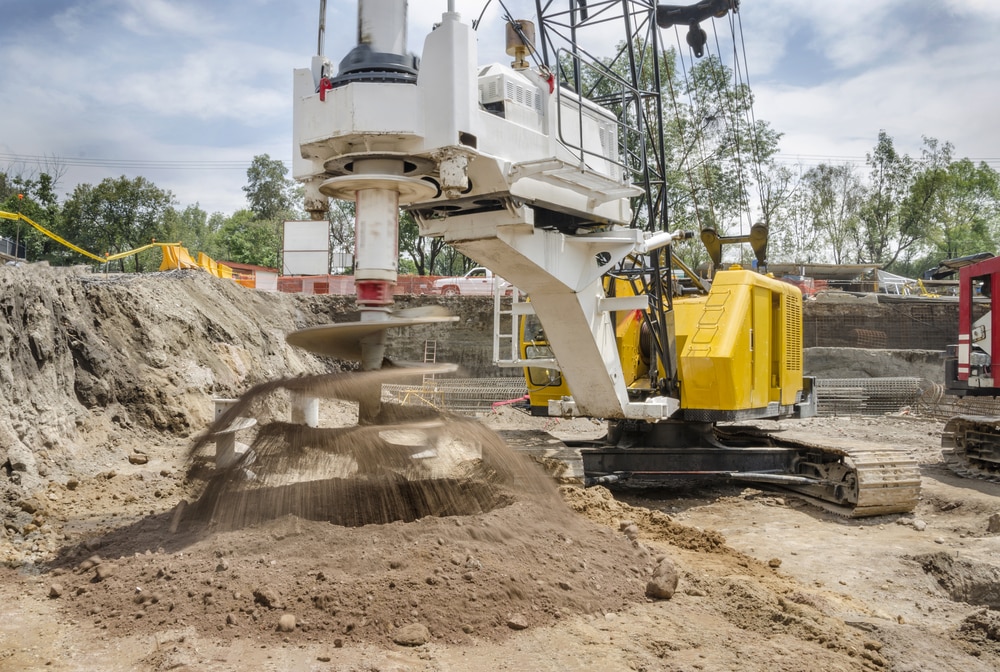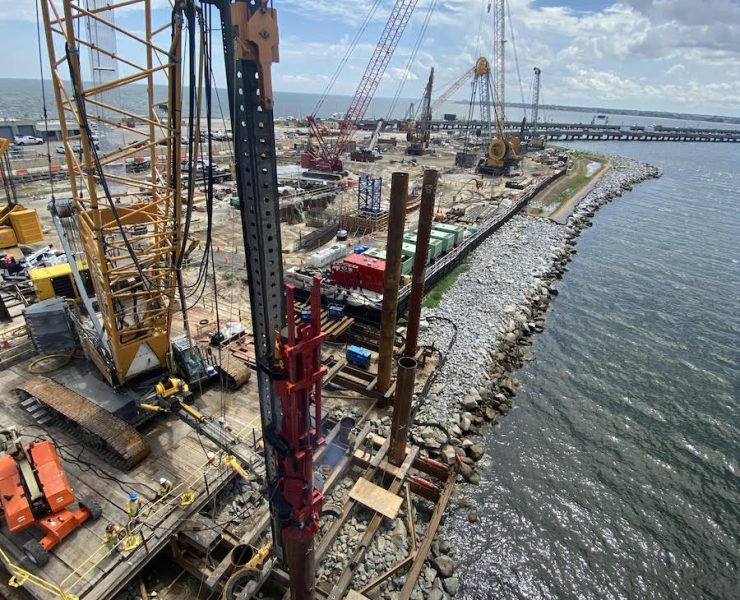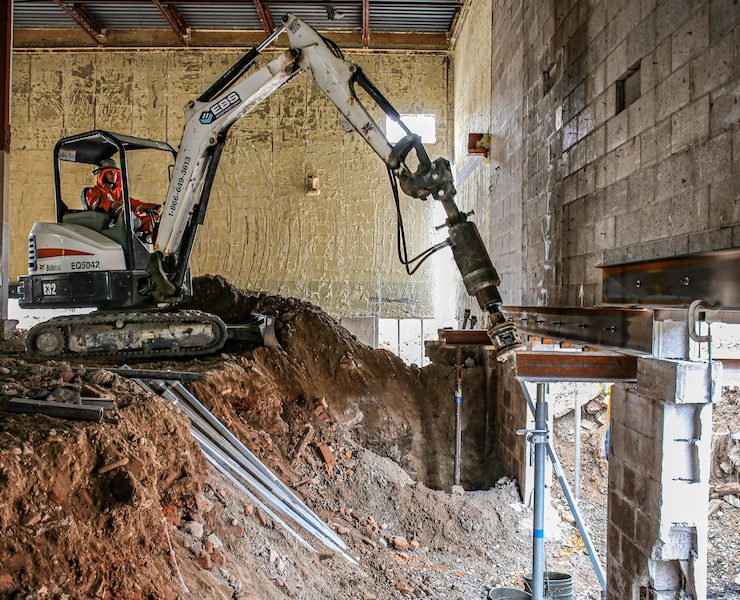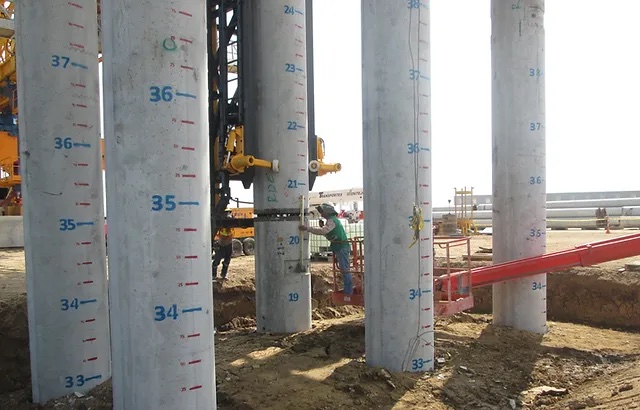Drilled Shafts: Tools & Equipment


View the complete article here.
Drilled shafts are often used for different types of construction projects such as bridges, towers, tanks, and buildings. These elements are high-capacity, cast-in place deep foundations, designed to support the construction project and reinforce the structure.
It is the contractor’s responsibility to choose the methods and means of drilled shafts construction, but all parties need to be familiar with the types of drilling tools and drilling rigs that might be used.
Overview of Drilled Shaft Creation
Typically, the drilled shaft is created using an auger. To create the planned shaft, first a hole is drilled with the specific diameter, which might require the use of drilling fluid or casing if assistance is needed to keep the hole open. Then, reinforcing steel is placed full-length within the hole, and the rest of the space is filled in with concrete. Once the foundation is finished, it will be strong enough to resist lateral, uplift and compressive loads.
Choosing the Right Drilled Shaft Rigs and Tools
If you are choosing the rigs and tools for a drilled shaft project, there are several considerations that need to be made to determine the right method for your requirements.
These are some of the things that should be examined:
- Subsurface Conditions
Check these conditions during the site investigation, and the information can also be found in the contract documents. Geotechnical reports are also essential for this process to characterize the subsurface conditions.
- Personal Experience
Previous projects can give insight into the way the project should be handled. If you have personal experience with projects that had similar conditions, then you should draw from those experiences to make improvements.
- Available Equipment
Consider the equipment that is available for you to use. Many contractors find that it is better to use specific equipment that is already available, especially if the contractor has previous experience with that type of equipment.
- Post-Construction Documentation
If you have access to information from other contractors in the area, it can be helpful to learn from their post-construction documentation. Look for projects that shared similar geology and design.
Overview of Drilling Machines
Once you have taken the above criteria into consideration, then it is time to choose the machines that will be needed for the drilled shafts.
Here is an overview of some of the popular machines that are used:
- Rotary Systems
It is common for drilled shaft machine to utilize a rotary function, and there is a wide variety of sizes and designs. This type of machine uses forces that are created from the power unit, which moves through the rotary onto a kelly bar. Then the tool is attached at the end of the kelly bar for drilling purposes.
- Hydraulic Power
The majority of the machines used today have a hydraulic system which administers the force to the rotary tables. Using hydraulic power increases the pressure that is available, creating a higher torque range. Additionally, the hydraulic power makes it possible to move the rotary up and down on the mast because it isn’t stuck in place by the drive system.
- Oscillator/Rotator Systems
Situations that require advancing and extracting casing might require the use of hydraulic-driven tools. The rotator or oscillator grips the casing using hydraulic power; then the pipe is twisted while the machine applies force in an upward or downward motion.
- Top-Drive Systems Mounted on Casing
Casing mounted top-drive systems can be used for reverse circulation drilling. This rig is mounted directly on the casing and uses a full-face cutting head on the rotary. As a result, it is easier to break up the rock or soil, and a drilling fluid is pumped into the hole to move things away from the cutting surface.
- Manual Methods
In most situations, manual methods are not preferred because of the time and effort that is required. But, certain projects require these methods, such as vertical mining or any construction that requires an underpinning of existing structures.
Manual excavation is typically more expensive, and a great deal of care needs to be placed on safety since it requires the use of workers below the surface. This method is only considered if the mechanical equipment can’t access the location or the machines will be ineffective for the circumstance.
Overview of Drilling Tools
Drilling tools might be used as stand-alone tools for certain projects, or they can be utilized in conjunction with the drilling machines and methods that were listed above. These tools vary in size, allowing you to choose sizes in 6-inch increments, up to a diameter of about 10 feet. Some of the common tools used for drilling shafts include:
- Augers
A versatile tool used for different rock types and soil conditions. This tool is often considered when the rocks or soil have a degree of cohesion since the cutting edge can rip the rock and break the soil. As the auger is withdrawn from the hole, it brings up the cuttings and empties while it spins.
- Earth Augers
Auger may have a stand-alone cutting surface or a double surface. Usually, they are built with a central point, known as a “stinger” to prevent wobbling when the auger is in motion. Double augers are needed if stronger geomaterials are present.
- Rock Augers
Soft rocks, such as soft limestone, sandstone, and hard shale, can be drilled using a flight auger. The auger is made with a hard surface and conical teeth, often using tungsten carbide.
- Drilling Buckets
For soil formations without rock, drilling buckets can be used. The rotary digging action forces the soil to go through the slots in the bottom of the bucket and flaps prevent the soil from falling back out again through the slots. After the soil is loaded, the tool is pulled out from the hole and the bottom of the bucket hinges open to dump the load.
- Core Barrels
If the rock is too hard for excavation as detailed above, then the next step is to use a core barrel for excavation. The tool cores into the rock until a portion of the core breaks off, then the core barrel is lifted to remove the materials and unload on the surface. It is usually necessary to shake or hammer the core barrel to allow it to drop out.
- Full-Faced Rotary Tools
When rocks need to be drilled at a large depth, then full-faced rotary tools can be used. These tools have roller bits across the face of the tool. The bits grind the rock, and the ground pieces are moved to the top by flushing drilling fluid into the hole.
- Belling Buckets
Formed in the shape of a bell, the tool is lowered into the hole with the arms closed. Then, the downward force from the drilling machine causes the arms to be forced open, and the tool is rotated to cut the soil.
For the drill to be moved around the site, it is necessary to have it mounted on a carrier such as a crane, excavator, crawler, or truck.
- Truck Mounted
Machines mounted on a truck offer the most mobility and these tools can range in drilling capacity and size. Most truck-mounted rigs can start drilling within minutes of reaching the drilling location.
- Crane Mounted
Drilling rigs mounted on cranes are beneficial because of the versatility and capabilities that aren’t available with a truck-mounted tool. But, these drilling tools aren’t quite as mobile compared with a truck unit and they require assembly of the equipment which can increase costs. Cranes are most useful for bridges, especially when the bridge is being built over water.
Cleaning Tools for the Base of the Drilled Shaft Excavation
During the drilling, it is essential to remove debris and cuttings from the bottom of the shaft. Most systems use a pump to pick up the cuttings to remove them from the drilled area. There are two common types of pumps:
- Air-Lift Pump
This tool uses air that is pumped down the supply line. The air enters the pipe near the bottom of the drill shaft. The rising column of air lifts the fluid within the pipe. Suction is the force that brings up the loose material or sand. Compared with hydraulic pumps, the air-lift pump is better for larger particles.
- Hydraulic Pump
Two hydraulic lines are needed when using a hydraulic pump. The hydraulic pressure causes the impeller to rotate and pump the fluid upward. These pumps are easier to control compared with the air-lift system and the user can regulate the velocity and volume of the pumping.
Stabilization for the Drilled Shaft
If there are voids within the drilled shaft, then it might be necessary to use grouting to treat a specific zone that contains permeable, low-strength material that is trapped within the shaft concrete. Although it is rare, compaction or permeation grouting might be used to stabilize a very large hole or an unstable area.
- Cement
Stabilizing a column of soil at the location of the drilled shaft excavation can be accomplished with soil mixing.
- Concrete Liner
An unstable formation can be strengthened with a concrete lining created using a special under-reaming tool. This method isn’t commonly used.
Choosing the Right Drilled Shaft Equipment
As you can see, there are many options from which to choose if you need drilled shafts for your construction project.
Before selecting the equipment and method that you will be using, it is best to consider the specifications and geomaterials for the project in order to choose the right drilled shaft machines and tools.
View the complete article here.
What are the most common tools used for drilling shafts?
Some of the common tools used for drilling shafts include: Augers, Earth Augers, Rock Augers, Drilling Buckets, Core Barrels, Full-Faced Rotary Tools, Belling Buckets.
What are the mounting methods for a Drilling Machine?
For the drill to be moved around the site, it is necessary to have it mounted on a carrier such as a crane, excavator, crawler, or truck.

















